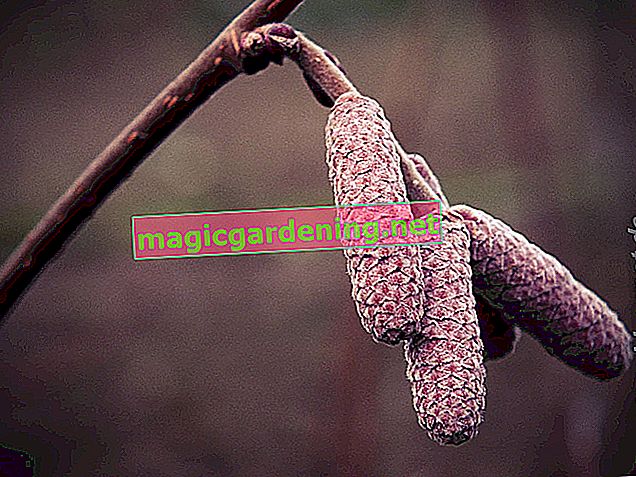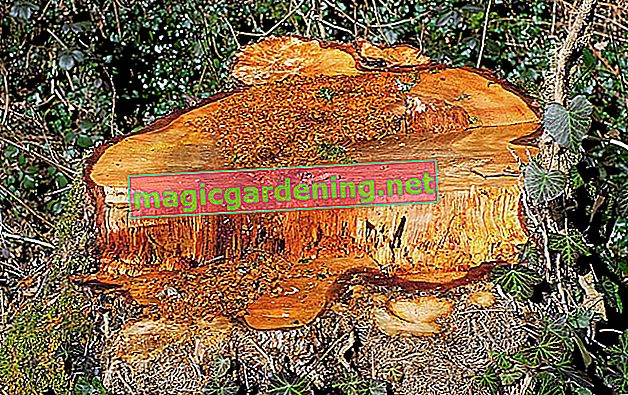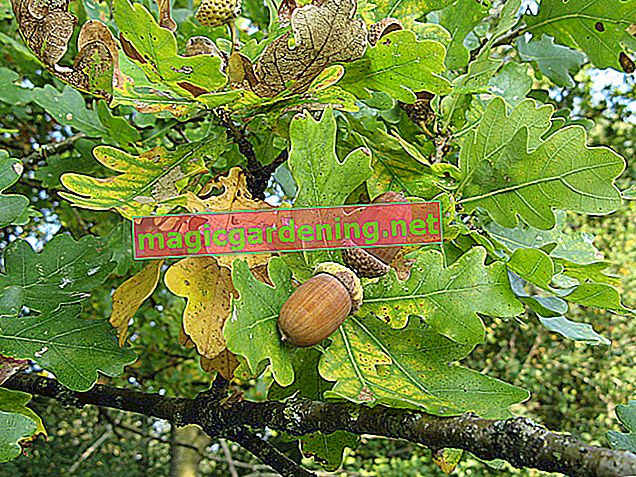
Events and dates for a cut at a glance
The wig bush belongs to the illustrious circle of ornamental trees, which can confidently do without a body cut. An annual shape and clearance cut is also not a mandatory part of the maintenance program. Nevertheless, there are various occasions that make it useful to use scissors and saws. The following table gives you all the options for a cut on the wig tree:
also read
- How to cut garden hibiscus exemplary - cutting tutorial for beginners
- How to cut camellias in an exemplary manner - cutting instructions for beginners
- Pruning plum tree - tutorial for beginners
| Cut type | target | Period / occasion | meeting |
|---|---|---|---|
| Body section | controlled growth, regulation of spread | from the 2nd year | in the spring before budding |
| Clearance cut | Preservation of vitality, flowers and fruit decorations | every year or every 2 to 3 years | in late winter until March 1st |
| Topiary | Promotion of young, intensely colored leaves | from the 2nd year of standing or from reaching the desired height | before budding |
| Taper cut | Rebuild the old shrub | in the event of aging due to neglected cut care | in late winter until March 1st |
| Cut back | Compensation for lost root volume | after transplanting | immediately after the change of location |
For home gardeners with a penchant for self-tied dry bouquets and a knack for imaginative arrangement creations, there is another cut option. When the branches brag about their fluffy wigs in autumn, the most beautiful shoots can be cut without hesitation.
Instructions for a construction cut
As a solitaire, a wig bush shows itself from its most beautiful side and does not need a structural cut. In the small garden or together with other ornamental trees to form a decorative group, the type of cut comes into focus. As part of a well-thought-out upbringing, you set the course for controlled growth with a limited number of scaffolding shoots. This pruning measure at the same time dampens the urge to spread at the beginning, because low-lying foothills can hardly form. This is how an exemplary structure succeeds:
- In the spring of the 2nd year of standing, select the 5 to 7 strong ground shoots for the scaffolding
- Cut excess and weak ground shoots at the base
- Do not shorten scaffold shoots in order to preserve the inflorescences and fruit stands
If the selected scaffold shoots with numerous side branches get into each other's enclosure, please do not cut off the shoot tips. Rather, you remove the weakest and unfavorably positioned side shoots. With this cut you slim down the wig bush without affecting the natural shape.
Instructions for the clearance cut
The most common type of cut on the wig bush focuses on removing dead or unfavorably standing shoots. The aim is an airy, loose growth of ground shoots and their branches. If a wig bush can develop freely at the location, a clearing cut is usually recommended at intervals of 2 to 3 years. Here's how to do it properly:
- Thinning out dead wood
- Curved overhanging tips derive from young, vertical shoots
- Cut back or remove shoots that are directed into the interior of the shrub and growing crosswise
- Cut the branches that are rooted in the ground at the roots
The key to success in pruning is a targeted thinning of the wig bush without bothering the annual shoots with scissors. You can identify the valuable young wood of the previous year by its unbranched, upright growth. The figure below shows the correct procedure.

Topiary promotes luminous foliage
Some of the most beautiful varieties of the wig bush shine with intensely colored decorative leaves. The premium variety 'Royal Purple' delights with black and red leaves. 'Golden Spirit' with its yellow-gold foliage is in the spotlight. The younger the leaves, the more intense the color. A vigorous pruning in the spring ensures that the shoots grow back throughout the summer and continuously sprout new, colorful leaves .
You can choose to start cutting from the second year of standing or wait until the wig bush has reached the desired height. How a cut promotes the luminosity of the leaves:
- In late spring, cut back all shoots to 30 to 100 cm
- Position the pruning shears 3-5 mm above an outward-facing leaf bud
- In addition, from the 5th year of standing, completely cut off the 2 to 3 oldest scaffold or ground shoots
- Optionally, cut back this year's growth after St. John's Day (June 24th)
By picking up scissors again at the end of June / beginning of July, you can use the second leaf shoot for a colorful end to the year for your wig bush. Provided that the weather conditions are suitable, the ornamental wood will sprout again in late summer with freshly colored, young decorative leaves. Before the leaves are shed, the color festival ends in warm, autumnal shades.
The disadvantage of this pruning is the lack of autumnal fruit stands . A wig bush planted its flower buds last year. With every cut of the annual shoots, the flower systems for this year's season are destroyed without replacement.
Digression
Vitality test
A wig bush often does not develop its leaves and flowers until mid-May to early June. This growth behavior induces the home gardener to remove a shoot as dead wood, although it is still full of life. You can avoid this fallacy with a vitality test . On the branch in question, scrape off the bark a little. If light to green tissue emerges, the shoot is no match for scissors or a saw. If, however, brown discolored, dry tissue is exposed, it is actually dead wood.Rejuvenate the wig bush - this is how it works
A wig bush ages faster without a clearing cut. There are hardly any young ground shoots that can replace old scaffold shoots. The branches shade each other in the dense network, so that the flagging photosynthesis causes the shoots to bald. The abundance of flowers and fruit decorations are noticeably diminishing. With a courageous rejuvenation cut you restore the well-groomed appearance and revitalize the shrub as a whole. How to proceed correctly step by step:
- Saw off all dead ground shoots at the base
- Outdated scaffold shoots with overhanging brooms lead to a young side shoot below
- Select the desired number of new scaffold shoots from the young ground shoots
- Remove excess, weak ground shoots
The illustration below shows how you can professionally rejuvenate an old wig bush. Apart from the procedure, the choice of date is of particular importance. According to the Federal Nature Conservation Act, radical pruning measures on woody trees are permitted between October 1st and March 1st. This exception only applies if it is ensured in advance that there are no wild animals in the wood.

Relocation requires targeted pruning
The wig bush thrives as a heart root with a root system that goes deep and wide. Compared to shallow roots such as forsythia or pipe bushes, it is difficult for the wig tree to re-root after a change of location. Within the first five years of standing there are still quite good prospects of successfully transplanting the ornamental wood. The risk of failure is significantly reduced if pruning compensates for the lost root volume. This is how transplanting and cutting go hand in hand:
- Dig up the wig bush with as much root volume as possible and plant in the new location
- Cut back all shoots by a third to half
- Start each cut a short distance from a bud or a sleeping eye
Determine the extent of the pruning so that in the end the balance between underground and above-ground growth is restored.
frequently asked Questions
Is the wig bush poisonous?
Botanists assign the wig shrub to the Sumanaceae family (Anacardiaceae). Therefore the ornamental wood is distantly related to nasty plants like the dreaded poison ivy. It is therefore to be feared that the sap of a wig bush is not completely harmless. Sensitive people with a pronounced susceptibility to allergies should wear gloves as a precaution when caring for cuts.
How hardy is a wig bush really?
Competent nurseries offer the wig tree for all gardens from winter hardiness zone 6 a. This categorization implies frost resistance down to - 23.3 degrees Celsius. However, this value can only be viewed as a guide. Freshly planted young shrubs require light winter protection in the first two years of standing. In the bucket, a wig bush without a translucent hood and a warm winter coat made of fleece does not get through the cold season without damage.
My wig bush doesn't bloom and doesn't wear wigs either - why is that?
The most frequent cause of the failure of the summer bloom and autumn wig fruits is an incorrectly chosen cutting time. A wig bush creates the buds for the next flowering period in the previous year. If it is pruned in spring, most of the flower buds fall victim to it. Limit pruning to a thinning cut in late winter. Do not cut back the annual shoots. Too long, arching overhanging branches can be derived from a young side branch.
The 3 most common mistakes
The good-natured cut tolerance of a wig bush cannot prevent a disappointing result if the gardener makes one of the following mistakes. This table gives you the 3 most common mishaps in pruning and gives practical tips for regulation or prevention.
| Cutting errors | Result | Correction / prevention |
|---|---|---|
| never exposed | Aging, fewer and fewer flowers and wigs | Rejuvenation cut, then a clearance cut every 1 to 3 years |
| put on the stick | no or poor new growth | Thinning out dead wood, diverting aged branches to a young side shoot |
| cut in autumn | Frost damage as a result of late budding | cut in spring, just before budding |
The good winter hardiness of wig bushes will come to nothing if you make one of the most common mistakes and do the cut in autumn. In this case, the growth laws cause a fresh, soft shoot at the shoot tips. Until the onset of winter, there is too little time for the branch tips to mature and lignify. The result is irreparable frost damage.
YoutubeTips
Over the years, the outer branches of the wig bush lay like a drag on the ground and take root quickly. These sinkers are perfect for uncomplicated propagation. Do not cut off a healthy, strong shoot, but wait until it has developed its own root system. Only then is the mother plant and offshoot separated. Dig up the offspring and their roots and plant them in a new location.








